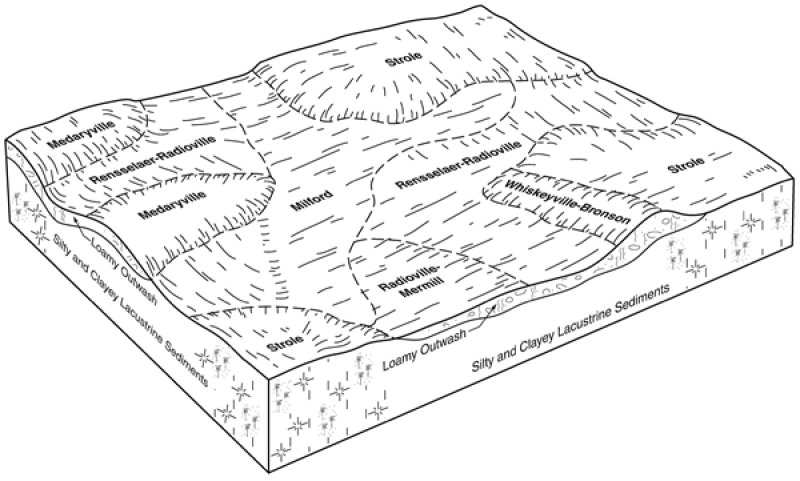
Natural Resources
Conservation Service
Ecological site R111XC008IN
Wet Overflow
Accessed: 11/21/2024
General information
Provisional. A provisional ecological site description has undergone quality control and quality assurance review. It contains a working state and transition model and enough information to identify the ecological site.
MLRA notes
Major Land Resource Area (MLRA): 111X–Indiana and Ohio Till Plain
A PROVISIONAL ECOLOGICAL SITE is a conceptual grouping of soil map unit components within a Major Land Resource Area (MLRA) based on the similarities in response to management. Although there may be wide variability in the productivity of the soils grouped into a Provisional Site, the soil vegetation interactions as expressed in the State and Transition Model are similar and the management actions required to achieve objectives, whether maintaining the existing ecological state or managing for an alternative state, are similar. Provisional Sites are likely to be refined into more precise group during the process of meeting the APPROVED ECOLOGICAL SITE DESCRIPTION criteria.
This PROVISIONAL ECOLOGICAL SITE has been developed to meet the standards established in the National Ecological Site Handbook. The information associated with this ecological site does not meet the Approved Ecological Site Description Standard, but it has been through a Quality Control and Quality Assurance processes to assure consistency and completeness. Further investigations, reviews and correlations are necessary before it becomes an Approved Ecological Site Description.
111C – Indiana and Ohio Till Plain, Northwestern Part. This MLRA is in the glaciated part of north-central Indiana and is dominated by glacial till plains broken in places by lake plains, outwash plains, and flood plains. Areas that parallel most of the major rivers and streams have deposits of sand.
Although it is an important agricultural region, MLRA 111C hosts a large proportion of Indiana’s biodiversity.
Classification relationships
Major Land Resource Area (MLRA)(USDA-Natural Resources Conservation Service, 2006)
USFS Ecological Regions (USDA, 2007):
Sections - Central Till Plains, Beech Maple (222H), South Central Great Lakes (222J), Central Till Plains and Grand Prairies (251D)
Subsections - Kalamazoo-Elkhart Moraines and Plains (222Jh), Steuben Interlobate Moraines (222Ji), Bluffton Till Plains (222Ha), Entrenched Valleys (222Hf), Miami-Scioto Plain-Tipton Till Plain (222Hb), Kankakee Sands (251Dg) and Eastern Grand Prairie (251Dd).
NatureServe Systems anticipated (NatureServe, 2011): Agriculture-Pasture/Hay, Agriculture-Cultivated Crops and Irrigated Agriculture, Central Tallgrass Prairie, Harvested Forest-Grass Regeneration, Harvested Forest-Herbaceous Regeneration, Introduced Upland Vegetation – Treed, North-Central Interior Sand Gravel Tallgrass Prairie.
LANDFIRE Biophysical Settings anticipated (USGS, 2010): North-Central Interior Sand and Gravel Tallgrass Prairie, Central Tallgrass Prairie, Great Lakes Wet-Mesic Lakeplain Prairie.
Ecological site concept
This site is an upland site formed on glacial outwash and colluvium parent materials in soils that are very poorly or poorly drained. There are 3 distinct states: 1. wet prairie (reference state), 2. woodland state, and 3. agriculture state. The combination of accumulation of organic material and seasonal changes in water which led to an increased probability of fire limited the encroachment of woody species. Currently, over 80% of this site is in agricultural production, with the majority being used to raise corn and soybeans.
Associated sites
| F111XC009IN |
Overflow The Overflow site is often adjacent and of better drainage. |
|---|---|
| R111XC010IN |
Well Drained Overflow The Well Drained Overflow is often adjacent and of much better drainage largely due to steeper slope. |
Similar sites
| R111XC002IN |
Wet Sandy Interdune The Wet Sandy Interdune is has bluejoint as the major dominant species. |
|---|
Table 1. Dominant plant species
| Tree |
Not specified |
|---|---|
| Shrub |
Not specified |
| Herbaceous |
(1) Andropogon gerardii |
Click on box and path labels to scroll to the respective text.
